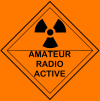BBC Performance Tracker – notification of changes
Ofcom is proposing to make changes to its BBC Performance Tracker to ensure it remains up-to-date and fit for purpose
IARU R2 Emergency Communication and Satellite Workshops to be online
With the travel restrictions and self-isolation requirements of many countries due to COVID-19, the May 30 and 31 workshops will be online
RSGB Train the Trainers event Telford is postponed
The upcoming RSGB Train the Trainers event hosted by TDARS in Telford is now postponed due to the Coronavirus situation
Coronavirus: RSGB Amateur Radio Exams
The RSGB has announced they are offering clubs new flexibility if they need to postpone exams during the current Coronavirus situation
RAC Head Office closed temporarily
The rapidly evolving coronavirus (COVID-19) situation has now reached Ottawa, where the Radio Amateurs of Canada Head Office is located, and medical officials have requested that all individuals should remain in their homes and limit non-essential travel
Amateur Radio Homebrewing Hack Chat
Hackaday's Dan Maloney KC1DJT says join us on Wednesday, March 18 at noon Pacific Time (1900 GMT) for the Amateur Radio Homebrewing Hack Chat with Charlie Morris ZL2CTM
Sweden's national ham radio society cancels AGM
Due to the spread of the Coronavirus virus, the Board of SSA has unanimously decided to cancel the annual meeting which would have taken place on Sunday, April 26, 2020 in Östersund
All Ham radio amateurs invited to participate at the VERON VHF QSO party
Now the flea market at Rosmalen can’t continue due to the new measures to stop spreading the corona virus, VERON is organizing a VHF QSO Party from 21 March till 22 March
WRTC 2022 Organizing Committee Sticking to Schedule for Now
The World Radiosport Team Championship 2022 (WRTC 2022) Organizing Committee is, at least for now, staying on course for the event in Italy, in light of restrictions caused by the coronavirus pandemic. “We understand this is disrupting travel and operating plans in ways that affect different areas of the world unequally. However, it is not realistic for us to predict the extent and evolution o...
One VHF-UHF-Microwave Conference Postponed, Another Canceled
One of two US VHF-UHF-microwave groups has canceled its 2020 conference, while another has postponed its event. The Southeastern VHF Society (SVHFS) Board of Directors has announced the indefinite postponement of the annual SVHFS Conference. “Because of the health and safety concerns of our society members and the uncertainty of time of our national emergency caused by the coronavirus pandemic, ...
AC4XQ Repeater System
Home of the C3I Amateur Radio Group
K1SV SOVAR
Southern Vermont Amateur Radio Club
The UH Ham Club
A Registered Independent Organization (RIO) of the University of Hawaii at Manoa
IV3ONZs Ham Radio Blog
Ham radio activity and homebrew from Italy with some interesting article on QRSS, decoding interfaces, APRS and antennas
W0KEN Hannibal Amateur Radio Club, Inc.
Northern Alberta Radio Club
The Northern Alberta Radio Club serves Edmonton, Alberta and area.
Google Earth Grid Square Locator
Software/Grid Bearing and Maps
This page host a simple Windows program that will create an overlay for Google Earth that displays the Maidenhead grid. If you only need 4-character locator coverage, you can download an alternative ready-to-use kmz-file.
ICQPodcast - Kit Building Tips
In this episode, Martin M1MRB is joined by Chris Howard M0TCH, Martin Rothwell M0SGL, Ed Durrant DD5LP and Frank Howell K4FMH to discuss the latest Amateur / Ham Radio news. Colin M6BOY rounds up the news in brief and this episode’s feature is - Kit Building Tips
NZART Conference update - Shantytown Conference 2020
As we are now in the grips of the global pandemic for Coronavirus (COVID-19) the organising committee of the Shantytown Conference 2020 has recently met to discuss a contingency should the event not be able to be held this year on the West Coast
The SARL 80m Club Sprint
The second leg of the 80m Club Sprint takes place on Wednesday 18 March from 17:00 to 18:00 UTC with phone and CW activity
NASA Administrator statement on agency coronavirus status
The following is a statement from NASA Administrator Jim Bridenstine: “As we navigate this difficult time, the protection and care of the NASA family continues to be our top priority and the key consideration as we make decisions on how to move forward"
COVID-19, Amateur Radio and the SARL
The Council of the SARL (South African Radio League) has taken note of the measures as announced by President Ramaphosa in his TV address to the nation on Sunday evening 15 March 2020
Update from the AMSAT President
The past six weeks since becoming AMSAT President has flown by with great speed. Thankfully I’m not travelling at 27,000 km/hour like our popular satellite AO-91
Amateur radio rallies and other events cancelled
A number of amateur radio events planned for March and April have been cancelled
Midway Island update
Ron, KH6DV, posted on March 14th, the following on QRZ.com:
"We all know that one of the easiest ways to catch a respiratory infection is to travel by airline, visit a hospital or clinic waiting room, or pass through an airport
AMSAT-Brazil QO-100 FT8 QRPp experiment
AMSAT-BR is organizing a reverse beacon FT8 QRPp experiment/contest via the QO-100 geostationary amateur radio transponder
Coronavirus: Ham radio youth events cancelled
A number of sub-regional events for young people in IARU Region 1 (Europe, Africa, Middle East) have been cancelled due to Coronavirus
Coronavirus: Hamvention 2020 cancelled
Hamvention 2020, planned to take place May 15-17 in Xenia, Ohio, has been cancelled
Dayton Hamvention Announces Cancelation of 2020 Show
For the first time in its 68-year history, Dayton Hamvention® will not take place this year, due to concerns about the coronavirus outbreak. The glum news was not entirely unexpected, given widespread cancelations of public gatherings and a national state of emergency. “The Hamvention Executive Committee has been monitoring the COVID19 pandemic. We have worked very closely with our local and st...
Watertown Amateur Radio Club, UA
the Watertown Amateur Radio Club located in Watertown, Wisconsin.
LARA Liberland Amateur Radio Association (LARA)
Liberland Amateur Radio Association (LARA)
PACARC Palestine/Anderson County ARC
This is the website of The Palestine/Anderson County Amateur Radio Club of Palestine, Texas
Indianapolis Repeater Association
Indiana's Premier Repeater Group An ARRL affiliated organization
NFLARC - The Navarro Amateur Radio Club
Navarro, Freestone, Limestone, Leon Amateur Radio Club.
A 30 Meter Sloping Dipole Antenna
Antennas/30M
This variation of the basic horizontal, half wavelength flat top dipole has proven to be a simple, effective antenna suitable for both home and portable use.
|







